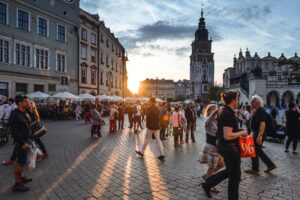
For community leaders aiming to capitalize on this powerful economic force, the challenge lies in attracting tourists in ways that are both effective and sustainable. Harnessing the right strategies can lead to a cycle of mutual benefit where tourists get to enjoy authentic experiences, and the community enjoys economic growth and development.
Emphasize Authentic Local Experiences
Tourists are increasingly looking for experiences that are unique and authentic. Gone are the days when a souvenir shop and a few scenic vistas were enough to satisfy the average traveler. Today’s tourists are seeking a deeper connection with the destinations they visit. Community leaders can foster this connection by promoting interactions with local artisans, musicians, and culinary experts.
By creating avenues for these authentic experiences—such as setting up local artisan markets, organizing live music nights, or hosting cooking classes featuring local cuisine—leaders not only make the tourist experience memorable but also channel revenue back into the community. This drives economic benefits to local talents and entrepreneurs who, in turn, become ambassadors for the community.
Revitalize Public Spaces
The power of public spaces in attracting tourists and enriching community life cannot be underestimated. Community leaders have an opportunity to revitalize underutilized spaces by converting them into engaging venues such as public art galleries, marketplaces, or community gardens. Such projects bring new energy and aesthetic appeal to an area, making it a popular spot for both locals and tourists.
An inviting public space not only provides a beautiful backdrop for tourist photos but also offers a commercial platform for local businesses. Food trucks, open-air cafes, or even local craft stalls can set up shop, providing multiple points of commerce where tourists can spend money. This dual benefit enriches the community economically and socially.
Cultivate Tourism Partnerships
Building strategic partnerships can significantly boost tourism and, by extension, the local economy. Community leaders can collaborate with travel agencies to create specialized tour packages, work with influencers to showcase local attractions, or even partner with nearby cities to create a circuit tour that benefits multiple communities.
Such partnerships don’t just put your community on the map; they provide valuable networking opportunities. They allow you to tap into the existing customer base of your partners, offering a more comprehensive experience to tourists. These alliances can result in packaged deals, special offers, and cooperative marketing campaigns that amplify tourist numbers and spending.
Offer Special Events and Festivals
One-off events and festivals can turn into major tourism pull factors if executed well. Such activities offer a rich playground for community leaders to showcase local culture, history, or special talents. Whether it’s a cultural heritage festival, a food and wine fair, or an arts and crafts exhibition, events provide a concentrated time frame where the community can engage with tourists.
By planning and executing events effectively, leaders can provide multiple opportunities for local businesses to benefit. Stalls, food and drink providers, transport services, and accommodation facilities all stand to gain from the influx of tourists. Special events become not just a showcase for the community but a marketplace for its businesses.
Adopt Innovative Marketing Strategies
Our digital presence can make or break a destination’s tourism prospects, so innovative online marketing is critical. Community leaders can harness platforms like Issuu to create a digital flipbook that highlights local attractions. This offers a cost-effective solution to printed content, allowing for easy updates and real-time distribution.
Such modern marketing tactics enable communities to stay competitive in a rapidly evolving tourism landscape. They appeal to a tech-savvy generation of tourists who rely on online information to plan their travels. A compelling online presence ensures that your community is readily discovered by potential visitors, significantly boosting its tourism profile.
Engage Local Businesses in Tourism
Local businesses are the lifeblood of any community and have a significant role to play in boosting tourism. Tailoring the community’s commercial offerings to tourist needs can make a substantial difference in its appeal as a travel destination.
Leaders can also organize training workshops and offer resources that help local businesses better understand and cater to tourist needs. The aim should be to transform these enterprises into integral parts of the tourism infrastructure. This not only boosts the tourist appeal of the community but provides a sustainable revenue stream for local businesses.
Invest in Tourism Training
A skilled workforce can elevate a tourist’s experience from average to exceptional. Investing in specialized training programs can go a long way in creating a service environment that impresses visitors. Community leaders can facilitate this by collaborating with local educational institutions to offer courses and certifications in hospitality, customer service, and tour operations.
Besides offering direct benefits in terms of enhanced service quality, these training programs also contribute to the community’s economic development. They generate employment opportunities and provide local businesses with the skills they need to excel in a competitive market, thereby attracting more tourists and encouraging repeat visits.
Make Information Easily Accessible
In the information age, lack of knowledge can severely hamper a tourist’s experience. Community leaders should aim to create robust information distribution systems. This can range from a user-friendly website with a comprehensive listing of local attractions, eateries, and lodging options to mobile apps that guide a visitor through the community.
Easy access to information benefits tourists by making them more comfortable exploring beyond the major attractions. It can translate into longer stays and greater economic contributions as tourists are encouraged to explore dining, shopping, and other leisure activities. Well-informed tourists are likely to have a fulfilling experience, making them ambassadors for your community.
Encourage Seasonal Tourism
Focusing solely on peak tourism seasons can lead to a neglect of opportunities that other times of the year might offer. Community leaders can work to market their location as a year-round destination. This can involve promoting winter sports, fall foliage, or seasonal festivals that extend the appeal of the community beyond the usual busy months.
Promoting off-season tourism can lead to a more sustainable model that allows local businesses to maintain more consistent operations. This level of economic stability is beneficial in creating permanent jobs and making revenue streams more predictable, helping both the community and local businesses plan and invest for the future.
Leverage Social Media
Community leaders should prioritize developing a strong social media strategy that includes regular posting of high-quality content that highlights the best the community has to offer. The benefits of an effective social media strategy extend beyond mere visibility. It creates an interactive platform where past, current, and future tourists can engage with the community. User-generated content, reviews, and testimonials can be leveraged to create an authentic narrative that further boosts tourism.
Seek Community Feedback
One of the most important yet often overlooked aspects of sustainable tourism is community feedback. To ensure long-term success, it’s crucial for leaders to regularly engage with local residents and business owners. This can take the form of community meetings, online surveys, or suggestion boxes placed in public areas.
Actively seeking and incorporating feedback ensures that tourism development is aligned with the community’s needs and aspirations. It fosters a sense of ownership among residents, making them more likely to contribute positively to tourism initiatives. By balancing the needs of tourists and locals, leaders can create a more harmonious and successful tourism ecosystem.
A Brief Summary
Community leaders hold the key to unlocking the immense economic potential of tourism. By focusing on authentic experiences, infrastructure, partnerships, and local engagement, they can create a tourism model that enriches the traveler and the community. When executed thoughtfully, these strategies lead to a sustainable cycle of economic growth and community development, making tourism a win-win for everyone involved.







